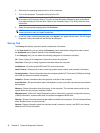
●
Embedded security device (some models)
●
SATA0
●
SATA1 (some models)
●
SATA4 (some models)
●
SATA5 (some models)
Network Service Boot Enables/disables the computer’s ability to boot from an operating system installed on a network
server. (Feature available on NIC models only; the network controller must be either a PCI expansion
card or embedded on the system board.)
System IDs Allows you to set:
●
Asset tag (18-byte identifier) and ownership tag (80-byte identifier displayed during POST).
See the Desktop Management Guide for more information.
●
Chassis serial number or Universal Unique Identifier (UUID) number. The UUID can only be
updated if the current chassis serial number is invalid. (These ID numbers are normally set in
the factory and are used to uniquely identify the system.)
●
Keyboard locale setting (for example, English or German) for System ID entry.
DriveLock Security Allows you to assign or modify a master or user password for hard drives. When this feature is
enabled, the user is prompted to provide one of the DriveLock passwords during POST. If neither
is successfully entered, the hard drive will remain inaccessible until one of the passwords is
successfully provided during a subsequent cold-boot sequence.
NOTE: This selection will only appear when at least one drive that supports the DriveLock feature
is attached to the system.
See the Desktop Management Guide for more information.
System Security (some
models: these options
are hardware
dependent)
Data Execution Prevention (some models) (enable/disable) Helps prevent operating system security
breaches.
Virtualization Technology (some models) (enable/disable) Controls the virtualization features of the
processor. Changing this setting requires turning the computer off and then back on.
Virtualization Technology Directed I/O (some models) (enable/disable) Controls virtualization DMA
remapping features of the chipset. Changing this setting requires turning the computer off and then
back on.
Trusted Execution Technology (some models) (enable/disable) Controls the underlying processor
and chipset features needed to support a virtual appliance. Changing this setting requires turning
the computer off and then back on. To enable this feature you must enable the following features:
●
Embedded Security Device Support
●
Virtualization Technology
●
Virtualization Technology Directed I/O
Embedded Security Device Support (some models) (enable/disable) Permits activation and
deactivation of the Embedded Security Device. Changing this setting requires turning the computer
off and then back on.
Table 2-4 Computer Setup—Security (continued)
Computer Setup (F10) Utilities 9


















